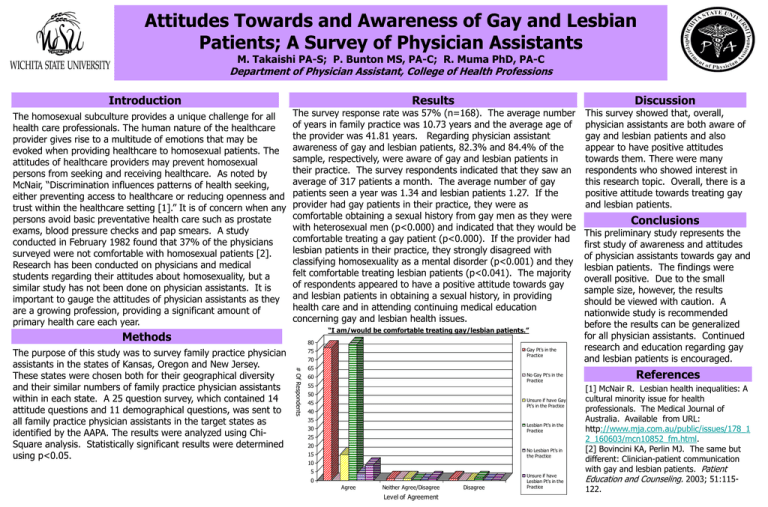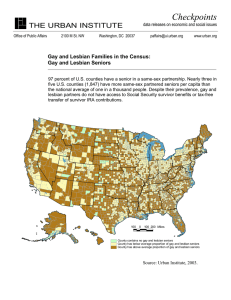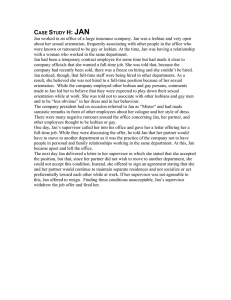pa0605018.ppt
advertisement

Attitudes Towards and Awareness of Gay and Lesbian Patients; A Survey of Physician Assistants M. Takaishi PA-S; P. Bunton MS, PA-C; R. Muma PhD, PA-C Department of Physician Assistant, College of Health Professions Introduction Results The survey response rate was 57% (n=168). The average number The homosexual subculture provides a unique challenge for all of years in family practice was 10.73 years and the average age of health care professionals. The human nature of the healthcare the provider was 41.81 years. Regarding physician assistant provider gives rise to a multitude of emotions that may be awareness of gay and lesbian patients, 82.3% and 84.4% of the evoked when providing healthcare to homosexual patients. The sample, respectively, were aware of gay and lesbian patients in attitudes of healthcare providers may prevent homosexual their practice. The survey respondents indicated that they saw an persons from seeking and receiving healthcare. As noted by average of 317 patients a month. The average number of gay McNair, “Discrimination influences patterns of health seeking, patients seen a year was 1.34 and lesbian patients 1.27. If the either preventing access to healthcare or reducing openness and provider had gay patients in their practice, they were as trust within the healthcare setting [1].” It is of concern when any comfortable obtaining a sexual history from gay men as they were persons avoid basic preventative health care such as prostate with heterosexual men (p<0.000) and indicated that they would be exams, blood pressure checks and pap smears. A study comfortable treating a gay patient (p<0.000). If the provider had conducted in February 1982 found that 37% of the physicians lesbian patients in their practice, they strongly disagreed with surveyed were not comfortable with homosexual patients [2]. classifying homosexuality as a mental disorder (p<0.001) and they Research has been conducted on physicians and medical felt comfortable treating lesbian patients (p<0.041). The majority students regarding their attitudes about homosexuality, but a of respondents appeared to have a positive attitude towards gay similar study has not been done on physician assistants. It is and lesbian patients in obtaining a sexual history, in providing important to gauge the attitudes of physician assistants as they health care and in attending continuing medical education are a growing profession, providing a significant amount of concerning gay and lesbian health issues. primary health care each year. “I am/would be comfortable treating gay/lesbian patients.” Methods Gay Pt's in the Practice 75 70 # Of Respondents The purpose of this study was to survey family practice physician assistants in the states of Kansas, Oregon and New Jersey. These states were chosen both for their geographical diversity and their similar numbers of family practice physician assistants within in each state. A 25 question survey, which contained 14 attitude questions and 11 demographical questions, was sent to all family practice physician assistants in the target states as identified by the AAPA. The results were analyzed using ChiSquare analysis. Statistically significant results were determined using p<0.05. 80 65 No Gay Pt's in the Practice 60 55 50 Unsure if have Gay Pt's in the Practice 45 40 35 Lesbian Pt's in the Practice 30 25 20 No Lesbian Pt's in the Practice 15 10 5 0 Agree Neither Agree/Disagree Level of Agreement Disagree Unsure if have Lesbian Pt's in the Practice Discussion This survey showed that, overall, physician assistants are both aware of gay and lesbian patients and also appear to have positive attitudes towards them. There were many respondents who showed interest in this research topic. Overall, there is a positive attitude towards treating gay and lesbian patients. Conclusions This preliminary study represents the first study of awareness and attitudes of physician assistants towards gay and lesbian patients. The findings were overall positive. Due to the small sample size, however, the results should be viewed with caution. A nationwide study is recommended before the results can be generalized for all physician assistants. Continued research and education regarding gay and lesbian patients is encouraged. References [1] McNair R. Lesbian health inequalities: A cultural minority issue for health professionals. The Medical Journal of Australia. Available from URL: http://www.mja.com.au/public/issues/178_1 2_160603/mcn10852_fm.html. [2] Bovincini KA, Perlin MJ. The same but different: Clinician-patient communication with gay and lesbian patients. Patient Education and Counseling. 2003; 51:115122.


